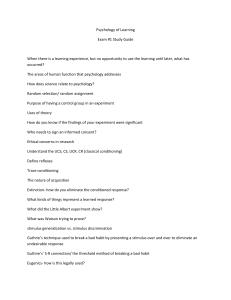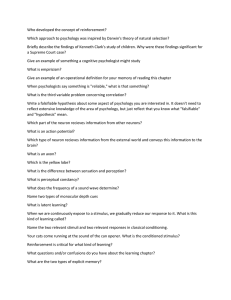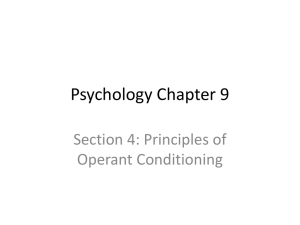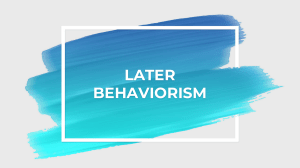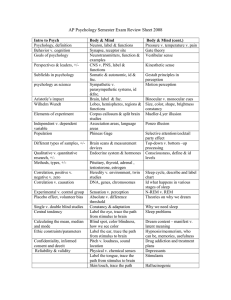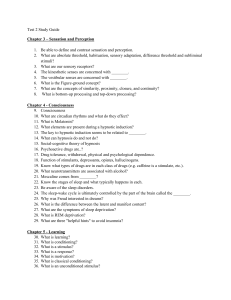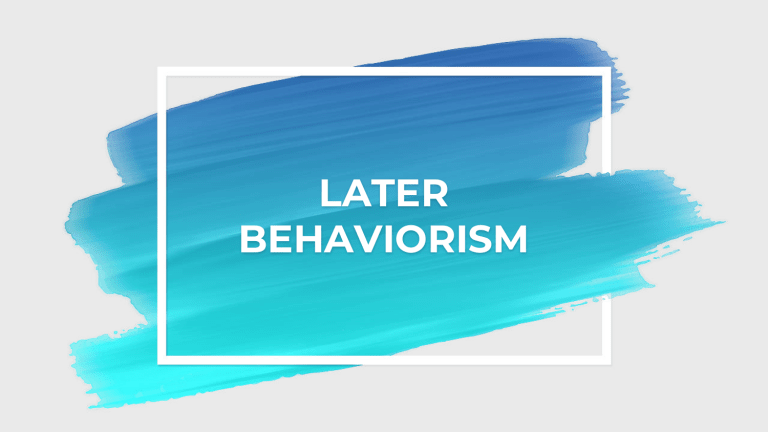
LATER BEHAVIORISM Edwin Guthrie ● Guthrie was born in Lincoln, Nebraska on Jan. 9, 1886 ● He received his PhD in philosophy from the University of Pennsylvania (1912), and joined University of Washington (1918) as an assistant professor ● Published Psychology of Learning (1935). ● Collaborated with Horton (1936 -39) on stereotypical behavior of cats in a puzzle box. ● Revised The Psychology of Learning (1952) ● Received a gold medal form American Psychological Foundation (1958). Law of Contiguity ● A combination of stimuli which accompany a movement will on its recurrence, will be followed by that movement. ● Later, Guthrie revised the Law of Contiguity to state “What is being noticed becomes a signal for what is being done” 3 One Trial Learning ● A stimulus pattern gains its full associative strength on the occasion of its first paring with a response Aristotle (Repetitive Trials) Guthrie (One Trial) S-R S-R S-R S-R S-R Strong Association Strong Association Learn to stop the car when encounter a stop sign WHY DOES PRACTICE APPEAR TO IMPROVE PERFORMANCE? Movement - Pattern of motor or glandular responses. - are minute responses made by the muscles that get associated with impinging stimuli. Movements are learnt responses. Acts - Was a movement or series of movements that brought about some end result. - are a conglomerate of a number of learnt movements. - are learnt behaviors, like learning to press keys on a keyboard. Skills - are made up of many acts that are repeated (practice) to develop performance proficiency. Fast typing is a skill. Forgetting ● Like one-trial learning, forgetting also occurs in just one trial. In the presence of a stimulus pattern when an old movement is replaced by new movement forgetting takes place. ● For Guthrie, all forgetting involves new learning. Forgetting occurs only if an existing S–R association is interfered with in some way. ● Breaking Habits To break habits determine the cues (pattern of stimuli) that initiate the undesired habit. Replace the undesired habit with a desired habit in the presence of those cues. 1. Threshold Method 2. Fatigue Method 3. Incompatible Response Method 8 ● Also known as Tolerance Method Threshold Method ● This method involves presenting the stimulus that has been associated with the movements in such a manner that the response will not occur. Thus, the stimulus presented is so weak that it does not cause the response to occur. 9 ● Also known as Exhaustion Method Fatigue Method ● The stimulus is presented so frequently that the response is exhausted, allowing for new alternate response. 10 Incompatible Response Method ● Stimuli for the undesirable response are presented along with other stimuli that are incompatible with the undesirable response. 11 Side Tracking Habits ● Achieved by avoiding all the cues that elicit all the aspects of the undesirable habit. ● This involves leaving the situations in which the habits are most likely to occur. 12 ● Similar to motivation Punishment ● The effectiveness of punishment is determined not by the pain it causes but by what it causes the organism to do in the presence of stimuli that elicit undesirable behavior. 13 Motivation ● It increased the number and vigor movements that could achieve associative connections with stimuli. 14 Reward ● was given in a following series of acts, and that reward removed the organism from the stimuli that acted just prior to it. 15 Clark Leonard Hull ● Born Mar. 20, 1884 Susquehanna, Pennsylvania. ● Belonged to poor household. Contracted polio at 24. ● Completed his PhD (1918) from University of Wisconsin. Studied Aptitudes and hypnosis. ● Provoked by Pavlov to study conditioning. ● Wrote Principles of Behavior (1943), and A Behavior System (1952). 16 ● A systematic deductive derivation of the secondary principles of observable phenomena from a relatively small number of primary postulates. Hypothetico Deductive Theory ● Uses intervening variables as hypothesized physiological processes, to explain behavior. ● Hull formulated 16 (1943) postulates (18 postulates, 1951) and 12 corollaries. 17 Hypothetico Deductive Theory ● a biological need creates a drive in the organism, and the diminution of this drive constitutes reinforcement ● Hull defines reinforcement as drive reduction as opposed to “satisfying state of affairs”. 18 As the association between stimulus and the response strengthens, Hull says that the “habit” of giving that response to that stimulus increases. 19 ● probability of a learned response. Reaction Potential 20 J. R. Kantor ● received his Ph.D. at the University of Chicago in 1917. ● became a professor at Indiana University for 39 years. ● biggest contributions to psychology was his development of naturalistic viewpoints in psychology. ● Principles of Psychology (1924-1926), An outline of a Social Psychology (1929), A Survey of the Science Psychology (1933), Problems of Physiological Psychology (1947), and Interbehavioral Psychology (1958). 21 Interbehavioral Psychology ● Kantor feels that other theories of a behavioristic sort have placed too much emphasis on studying the responses of the organism and have neglected the equal importance of the stimulus. ● For Kantor, the subject matter psychology is the interactions organism and stimulus object. of of 22 ● RB - Reactional Biography ● SE - Stimulus Evolution ● M - Media of Contact ● HInterbehavior History 23 Stimulus object has a certain functions. ● Universal Stimulus Functions - are based on the natural properties of the objects themselves. - they are universal because they serve the same function for all members of a given species. ● Individual Stimulus Functions - are more unique and particular to a person. - it will depend on the previous contacts or interactions a person has had with that object. ● Cultural Stimulus Functions - are identified in such a way that they call out similar reactions in a group of people. - they are not universal, but may be shared by a community of individuals. 24 Burrhus Frederic Skinner ● Born in Susquehanna, Pennsylvania in 1904,. ● While in college, Skinner wanted to be a writer, but after having little success in this endeavor, he turned to psychology. ● After earning a PhD from Harvard, he taught at the Universities of Minnesota and Indiana before returning to Harvard, where he remained until his death in 1990. 25 Operant Conditioning ● It is the use of consequence/s to form or modify the occurrence of behavior. 26 B.F. Skinner devised a box which is called “SKINNER’S BOX”. In the box, there is push a button and food pellets inside a food dispenser. Then, he put hungry rat inside the box and since its hungry-the rat was restless and was moving around the box. Accidentally, the rat pushed the button, then food pellet appears from the food dispenser. And since, the rat was hungry he repeatedly push the button to get food pellets. 27 Four Procedures of Operant Conditioning 1. Positive reinforcement- it occurs when the behavior is followed by a favorable stimulus. 2. Negative reinforcement- it occurs when the behavior is followed by the removal of aversive/ unfavorable stimulus. 3. Positive punishment- it occurs when the behavior is followed by unfavorable/ aversive stimulus. 4. Negative punishment- it occurs when the behavior is followed by the removal of favorable stimulus. 28 ● A reinforcement schedule is simply a rule that states under what conditions a reinforcer will be delivered. There are two major schedules of reinforcement. Schedules of Reinforcement A. Continuous (CRF)occurs when reinforcement is given after every single desired behavior. B. Intermittent (INT)occurs when reinforcement is given after some behavior but never after each one. 29 Intermittent 1. Fixed Ratio- in this schedule, a fixed number of responses must be made before the reward is administered. 2. Variable Ratio- the number of responses determines the delivery of reinforcement; but the ratio changes from reinforcement to reinforcement. 3. Fixed Interval- in this schedule, the reinforcement will be delivered after a specified passage of time. 4. Variable Interval- in this schedule, the length of time is varied or unspecified before the delivery of the reinforcement. 30 ● sometimes called secondary reinforcers Conditioned Reinforcers ● are those environmental stimuli that are not by nature satisfying but become so because they are associated with such unlearned or primary reinforcers as food, water, sex, or physical comfort. 31 Superstitious Behavior ● the behavior develops accidentally reinforced. by being 32 Behavior Modification ● It involves shaping and selective use of positive reinforcement (primary or secondary) , as well as extinction. 33 Albert Bandura ● Born in Canada in 1925, but he has spent his entire professional life in the United States. ● He completed a PhD in clinical psychology at the University of Iowa in 1951 and since then has worked almost entirely at Stanford University, where he continues to be an active researcher and speaker. 34 Social Cognitive Theory ● Bandura takes a broad view of learning, believing that people learn through observing others and by attending to the consequences of their own actions. Although he believes that reinforcement aids learning, he contends that people can learn in the absence of reinforcement and even of a response. 35 ● Bandura believes that observation allows people to learn without performing any behavior. Observational Learning Modeling - the tendency of individuals to intake the behaviors they observe in others. ex. bobo doll 36 Vicarious Learning ● All behavior is followed by some consequence, but whether that consequence reinforces the behavior depends on the person's cognitive evaluation of the situation. 37 Self regulation ● Capacity to regulate the behaviors unlike animals.. 38 Self Efficacy ● The belief in your ability to perform a certain task or function - mastery experience - physical and emotional states - social modeling - social persuasion 39
